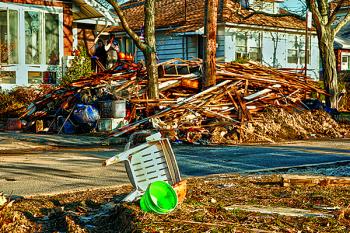
Flood: Safely remove, clean flooring
BATON ROUGE — As the clean-up process continues in homes that flooded across south Louisiana, LSU AgCenter housing specialist Claudette Reichel offers advice on what flooring should be removed, what can be salvaged, and how to clean and disinfect flooring.
Carpets and floors may be contaminated by mud, silt, sewage and mold. Reichel said carpets and paper-backed flooring in most cases should be removed and replaced.
“Pull up all saturated carpeting and rugs, roll them up and drag them outdoors,” Reichel said. “Wet carpet is very heavy.” She also said to discard and replace wet foam pads.
Reichel said some rugs or carpets can be salvaged:
—Valuable rugs that were not contaminated by hazardous chemicals, lead paint dust or asbestos, should be hosed off. Then work a low-sudsing, disinfecting carpet-cleaning product deep into soiled spots with a carpet shampooer or broom. Rinse and extract water with a steam cleaner, if possible.
—If areas of carpeting got wet from clean water leaks, extract water with a steam cleaner, if possible, and pull up and prop the wet carpet to dry. Cut away and replace any wet padding.
—If odors or mildew formed, consider (and test for colorfastness) a sanitizing rinse solution of one part of 3 percent hydrogen peroxide to five parts water or two tablespoons bleach to one gallon of water. Don’t use bleach on wool carpets.
Reichel said solid wood flooring can usually recover from flooding.
“Remove a board every few feet to reduce buckling caused by swelling,” she said.
For other flooring:
—Engineered wood and laminate flooring that swells or delaminates from flooding should be replaced.
—Solid vinyl and ceramic tile or stone flooring on a concrete slab may be cleaned in place. Sheet vinyl with paper backing is at risk of holding moisture and may support mold growth, so it may need to be replaced if discoloration or loosening occurs.
—If there is wood subflooring, it may swell and buckle or delaminate. If so, removal of flooring may be needed to hasten drying and replace damaged subflooring.
—Clean and dry wood subflooring before replacing floor covering.
—After cleaning, using a dehumidifier will greatly speed the drying process to avoid mold growth and allow faster restoration.
Reichel said once the flooring is removed, clean the slab or exposed subfloor first to remove soil with a nonphosphate all-purpose cleaner. Then disinfect it as a second step because flood water is contaminated with sewage.
- Log in to post comments
